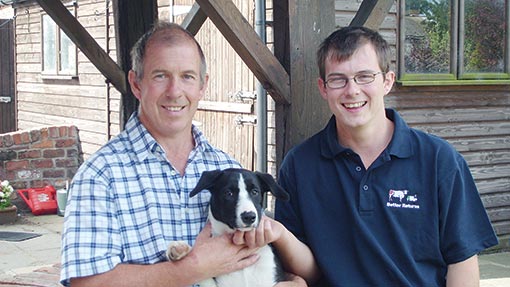Farmers reduce flock lameness using the five-point plan

The industry has made big strides in the fight against sheep lameness since the launch of Farmers Weekly’s Stamp Out Lameness campaign. Aly Balsom meets two farmers who are seeing the benefits of controlling the problem by using the five-point plan.
The financial impact of lameness became all to clear to David Venables this spring when a large proportion of his lambs took three weeks longer to hit finishing targets as a result of lameness.
With 60% of his early lambs affected and delayed finishing times costing up to 70p a lamb a day, based on a falling early season market and added costs, Mr Venables was keen to get the issue under control.
“You get slower growth rates in lame lambs as they don’t eat and perform as well,” says Mr Venables, who farms at Holly Tree Farm, Macclesfield.
As one of 19 sheep monitor farms looking at lameness, as part of an RDP-funded project, Mr Venables started working with Eblex and vet Jenny Torrance of Wright and Morten Vets. By adopting all parts of the five-point plan for controlling lameness (see box) he is now on track to eradicate lameness in his flock of 350 ewes.
Find out more about the five-point plan by visiting our Stamp Out Lameness homepage
Having identified lameness in 60% of early born lambs, and 12% of early lambing ewes, the first step was to treat the infection using appropriate antibiotics, says Miss Torrance.
“Anything that was not lame was also run through a formalin foot-bath to prevent them from getting infected,” she explains.
As a one-off, the second batch of lambs were vaccinated for foot-rot. This is not usual protocol, however, because the ewes had just been shorn it was not possible to vaccinate them and Miss Torrance had concerns over the infection pressure on the second batch of lambs. As a result, Mr Venables has witnessed little lameness in this group.
The plan now is to vaccine all breeding stock for foot-rot. The frequency and timing of this will be decided based on delivering the best protection at the time of highest risk.
With chronically infected ewes also posing a significant source of infection for lambs, culling repeat offenders will also be an essential part of lameness control. In general, if the problem is controlled in ewes, you are likely to see less lameness in lambs.
“We’ve never culled for lameness before, but now if a ewe has to be treated for foot-rot more than three times we cull,” says Mr Venables.
Any cases are treated promptly and Mr Venables has stopped foot-trimming animals with foot-rot, as this can reduce healing times. Bought in rams will also have their foot history checked before purchase and will be quarantined and vaccinated for foot-rot.
David Turner, Torpoint, Cornwall
Cornish farmer David Turner has recently adopted a similar, all-encompassing approach to control lameness in his flock of 1,800 ewes.
Mr Turner blames the mild, wet winter for the worst level of ewe lameness he’s seen in some time at Mendennick Farm, Torpoint.
“I’d say 10% of ewes were lame (this season), because of foot-rot or contagious ovine digital dermatitis (Codd), which is too high to me. Bad feet really give ewes a hard time so they can’t milk or graze, which ultimately affects the lambs,” he says.
The difficulty of treating lame ewes once they have lambs at foot means Mr Turner is particularly keen to address the problem. In the past, he had seen the benefits of vaccinating for foot-rot, but stopped once the problem was brought under control.
This year, he has decided to implement foot-rot vaccination again. Due to timings, Mr Turner has not yet been able to vaccinate all ewes and has noticed more lameness in the group of later lambing ewes that have not been vaccinated. From now on, ewes will be vaccinated as part of a set programme around tupping or scanning, just before the high challenge of wintertime.
Any lame ewe is treated promptly and will be culled if not cured after three treatments. The appropriate antibiotic will also be used depending on whether a ewe has foot-rot or Codd. Lime is put round troughs and bought-in animals are quarantined and will be vaccinated for foot-rot.
“We want to build resilience and reduce the challenge so in a poor, challenging year ewes are more able to cope,” he says.
“Lameness is an ongoing battle. We’ve always done bits and bobs (of the five-point plan), but now we do all parts so we can get on top of lameness.”
